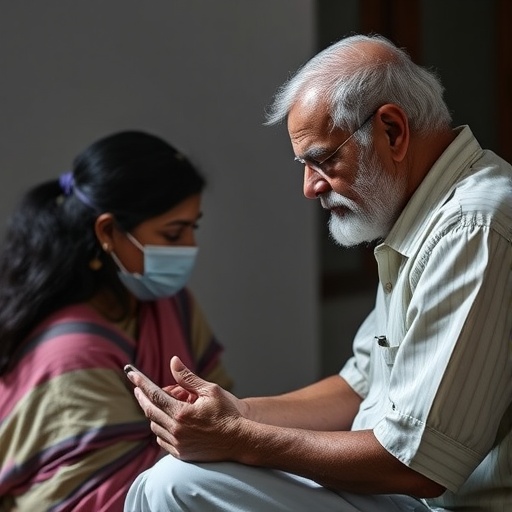A recent comprehensive study published in BMC Cancer sheds new light on the profound impact of myelofibrosis (MF) on patients’ quality of life (QoL) and productivity, particularly from the dual perspectives of healthcare providers and patients in India. This groundbreaking survey, conducted across multiple cities using detailed telephonic interviews, reveals critical insights into symptom burden, diagnostic challenges, and the nuanced disparities between physician and patient perceptions. As MF remains a rare and complex myeloproliferative neoplasm characterized by bone marrow fibrosis, anemia, and splenomegaly, this research emphasizes the urgent need for refined communication strategies and management protocols tailored to this demographic.
Myelofibrosis, a chronic and debilitating blood disorder, disrupts the normal production of blood cells due to scar tissue replacing bone marrow, leading to a spectrum of clinical manifestations. These include progressive anemia, enlarged spleen, debilitating fatigue, and constitutional symptoms such as fever and night sweats. The Indian context of this disease presents unique challenges—ranging from socioeconomic factors to healthcare accessibility—that exacerbate the burden on patients. The study illuminates the overlooked facets of MF’s impact within India’s healthcare framework, aiming to bridge existing knowledge gaps and guide future interventions.
This cross-sectional and multicentric survey took place between October and November 2021, spanning 17 cities and involving 50 physicians alongside 154 patients diagnosed with various subtypes of MF, including primary MF and post-polycythemia vera or essential thrombocythemia MF. Employing structured questionnaires designed around critical themes such as symptom burden, QoL parameters, treatment objectives, and patient-physician communication, researchers conducted one-on-one telephonic interviews. The methodology facilitated an in-depth capture of firsthand experiences and professional viewpoints, enabling a robust descriptive statistical analysis of the data collected.
.adsslot_dE31u8g5mG{ width:728px !important; height:90px !important; }
@media (max-width:1199px) { .adsslot_dE31u8g5mG{ width:468px !important; height:60px !important; } }
@media (max-width:767px) { .adsslot_dE31u8g5mG{ width:320px !important; height:50px !important; } }
ADVERTISEMENT
One of the most striking findings is the diagnostic delay associated with MF, with an average lag of approximately 10 months from the initial symptom onset to diagnosis. This delay exacerbates symptom progression and contributes significantly to patient morbidity. Early diagnosis is paramount in managing MF effectively, as it enables timely therapeutic intervention that can mitigate symptom severity and improve outcomes. The delay also underscores potential barriers within the Indian healthcare system, including limited disease awareness and resource constraints, which necessitate targeted educational efforts for both clinicians and patients.
The survey reveals a near-universal acknowledgment of reduced QoL among patients, with 98% reporting substantial quality of life impairment attributable to their condition. Fatigue, abdominal pain, and fever emerged as predominant symptoms from both patient and physician reports. Abdominal pain was noted by 81% of patients and 70% of physicians, while fatigue was identified by 77% of patients and 73% of physicians. Fever, a systemic symptom, was observed by 54% of patients versus 48% of physicians. These data indicate reasonable concordance between both groups on core symptoms, providing a foundation for symptom-targeted therapeutic strategies.
However, more concerning are the notable discrepancies between physician and patient perceptions regarding less overt but equally impactful symptoms. Differences were pronounced in domains such as bone pain, sleep disturbances, sexual dysfunction, depression, and physical inactivity. For instance, only 12% of patients reported bone pain compared to 64% of physicians who perceived this symptom’s prevalence. Similarly, sleep difficulties, sexual problems, depression, and inactivity were reported by fewer patients (8%, 2%, 4%, and 4%, respectively) but were significantly recognized by physicians (70%, 78%, 63%, and 66%). This divergence suggests either underreporting by patients or perhaps a lack of effective symptom elicitation during consultations.
These disparities in symptom recognition highlight critical communication gaps within the clinical encounter. Patients may feel discomfort or stigma discussing sensitive issues such as sexual health or psychological distress, while physicians may overestimate symptom burden based on clinical heuristics or observational cues. Addressing these gaps demands enhanced patient-centered communication training, psychosocial support integration, and careful symptom assessment tools adapted to cultural contexts that encourage open dialogue.
From a productivity standpoint, the study underscores the profound effect of MF on patients’ work lives. Over half (56%) of the patients indicated a negative impact on their work productivity attributable to MF, with 76% explicitly affirming that the disease hindered their daily work-related activities. Moreover, 42% reported reduced working hours due to their symptoms, revealing a tangible socioeconomic consequence of this chronic illness. These findings illuminate the broader ripple effect of MF beyond clinical morbidity, encompassing financial strain and diminished contribution to the workforce.
Given the chronic and progressive nature of MF, its deleterious effect on daily function prompts a re-evaluation of management strategies to incorporate supportive measures aimed at preserving productivity and mental well-being. Interventions such as symptom-modifying therapies, workplace accommodations, and rehabilitation should form an integral aspect of the care continuum, ensuring holistic management that transcends mere symptom control.
The study also touches upon patient journeys revealing possible systemic obstacles, including delayed symptom recognition, diagnostic inertia, and potential gaps in treatment continuity. These facets reflect the complexity of MF management in resource-limited settings, where infrastructural and educational enhancements could expedite diagnosis and optimize therapeutic timelines. Structured patient education initiatives, early referral pathways, and multidisciplinary care models emerge as vital solutions to address these challenges.
Importantly, the authors advocate for standardized monitoring practices that not only track hematologic parameters but also incorporate patient-reported outcomes and quality of life indicators. Such inclusive metrics would enable clinicians to tailor interventions more effectively, aligning treatment goals with patient priorities and real-world experiences. The integration of validated PRO tools into clinical practice may also enhance data-driven decision-making and longitudinal assessment.
The survey’s methodology, leveraging telephonic interviews across a wide geographical distribution, reflects an innovative approach to overcoming logistical hurdles in data collection during the pandemic era. This model offers a replicable framework for future epidemiologic or health services research in similar contexts, emphasizing the growing role of telecommunication technology in healthcare research.
Moreover, the juxtaposition of physician and patient perspectives generated insightful discourse on the subjective and objective facets of disease burden. While physicians possess clinical acumen to interpret physical signs and laboratory data, patient narratives enrich understanding through lived experience, psychosocial impact, and personal adaptation mechanisms. The study’s dual-perspective lens thus encourages a more empathetic and intersectional understanding of MF.
In conclusion, this investigation into the MF burden within Indian patients not only expands the epidemiological knowledge base but also spotlights critical communication and management gaps. The authors urge healthcare systems to foster enhanced dialogue between patients and providers, cultivate awareness around underappreciated symptoms, and prioritize multidimensional care that embraces both physical and psychosocial domains. Such advancements promise to ameliorate patient-centered outcomes and bridge disparities in care delivery.
As MF continues to pose significant challenges globally, region-specific studies such as this are invaluable for tailoring approaches that accommodate local healthcare landscapes, patient populations, and cultural considerations. By doing so, the medical community can aspire to transform MF care from reactive symptom management to proactive holistic wellness maintenance, ultimately improving patients’ lives beyond mere survival.
Subject of Research:
The impact of myelofibrosis on quality of life and work productivity from both healthcare personnel and patient perspectives in India.
Article Title:
Assessing myelofibrosis burden on QoL and productivity from healthcare personnel and patient perspectives in India.
Article References:
Chakrabarti, P., Bhave, A., Harrison, C. et al. Assessing myelofibrosis burden on QoL and productivity from healthcare personnel and patient perspectives in India. BMC Cancer 25, 1097 (2025). https://doi.org/10.1186/s12885-025-14324-4
Image Credits:
Scienmag.com
DOI:
https://doi.org/10.1186/s12885-025-14324-4
Tags: bone marrow fibrosis researchchronic blood disorders Indiacommunication strategies healthcarehealthcare accessibility myelofibrosishealthcare provider patient perceptionsmyelofibrosis management protocolsmyelofibrosis productivity impactMyelofibrosis quality of life Indiamyelofibrosis symptom burdenmyeloproliferative neoplasm challengespatient diagnostic challenges Indiasocioeconomic factors myelofibrosis





